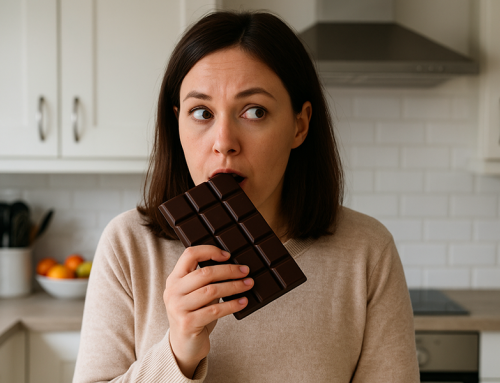The difference between success and failure isn’t whether you get off track, it’s whether you get back on track, and most important of all is how quickly you do it.
I recently hiked the 2200-mile Appalachian trail (AT) from my home state of New Jersey to the Southern terminus in Georgia.
The reason I was out there is because while weight training in the gym and healthy eating have always been my biggest passions in life, backpacking and exploring the outdoors are not far behind (plus, hiking fits pretty well into a fitness lifestyle – it gets you in great shape).

After trekking through the mountains of Shenandoah National Park, I’d been in the woods for five days without going into town. I was dirty, hungry, tired, and wet after the rain. On my last day before leaving the park, I was exhausted, but relieved to be cruising a downhill section, and I was daydreaming about a soft bed, a shower, and real food.
The trail kept going down for a couple miles and I didn’t realize the mistake I made until I looked up and saw a blue blaze on a tree. Blazes are painted markers that show you’re on the right path. That’s how I knew I wasn’t. The AT is marked with white blazes. Blue blazes mark spur trails leading off somewhere else. I had taken a wrong turn.
I knew where I was supposed to be going. The long term goal was Georgia – it was a couple months away. The short term goal was Waynesboro, Virginia – it was one day away. I wasn’t really lost – I was on a trail and it was well marked – I simply hadn’t been paying attention. I had to retrace my steps and go back uphill over all those rocks – four miles in total.
After I was on the AT again, my mind was preoccupied with this subject of getting off track. My detour caused a two hour delay, and I wasn’t happy, but there was nothing to do but get back to the right trail. You don’t sit on a log and complain, you don’t blame the forest service for not having better signs, you don’t blame the weather, you don’t quit – you keep going. It seems obvious.
My thoughts turned to fitness and weight loss, as they often do, and I got to thinking how this is what happens to most people their whole lives – they veer off their diet and training plan, and get on the wrong path. But the real problem is they keep going down the wrong path. Then, too often, a sidetrack turns into a rut, and they get stuck, or quit.
In fitness, success starts by understanding that you don’t have to be perfect to reach your goals, you simply have to be on track most of the time and promise yourself that you’ll never give up. You can prepare your mind by accepting that you’re going to be off track at times. You can even reframe it as part of succeeding – making mistakes is how you learn. You didn’t fail if you took a wrong turn, you’ve only failed if you quit – or as Napoleon Hill wrote, “Temporary defeat is not permanent failure.”
Everyone gets off track – it’s part of being being human. I get off track too. But as a serious student of both fitness and psychology, I’ve figured out how to almost instantly get back on track if I slip. Fitness is one area where I don’t struggle much, in large part because of mastering this one habit.
The secret is getting back on track quickly
There’s an old Turkish proverb, “No matter how long you’ve been traveling down the wrong road, turn back.” That’s the truth – it’s never too late to get back on track. But the longer you’re off, the more time you waste, the more ground you lose, the worse you feel, and the harder it is to start again.
The key to success is to stay aware of where you are, and the second you realize you’re off course, instantly make the decision to get back on track, and take action on that decision as soon as you can.
The big question is, “How specifically, do you get back on track quickly?”
The short version, and my best answer, is to tell yourself that you’re only one workout or one meal away from being on course again. You don’t have to make up miles and miles of lost ground to be on track again. You’re not days or weeks away from being on track again – you’re only one small step away. Eat the next healthy meal and your diet is back on track. Do the next scheduled workout, and your training is back on track.
If you stopped right here and put that one piece of advice to work, you’d be on your way again. But since so many people have a tough time with this, and still stay off course too long, I wanted to dig deeper into this question. When I gave it some thought, I realized that I had a system for it.
This is an 8-part formula. It’s what I’ve stumbled onto entirely from personal experience, but I think it matches up to what good psychologists would tell you too.
1. Take responsibility (avoid blame)
When you find yourself off track, it’s a common knee-jerk reaction to blame someone or something. Unfortunately, blaming keeps you off track because it keeps you in a negative mental state, and it’s an affirmation that you’re powerless to change.
Think about this: If you blame outside circumstances or other people for you being off course, that means they have to change before you can change. You could be waiting a long time for that, and the odds are, most things outside you are going to stay the same anyway. As Henry David Thoreau once said, “Things do not change, we change.”
You are the thing that has to change, but it can’t happen unless you accept that you may be the cause, and take responsibility for where you are.
In my book, Burn the Fat, Feed the Muscle I wrote about the importance of accepting responsibility for the shape you’re in, regardless of what you believe about your genetics or natural body type. The empowering mindset is to focus on doing the best you can with what you’ve got. It’s every bit as important to accept responsibility if you find yourself off track, regardless of what’s going on outside you.
Some things are out of your control, and things happen that can knock you off course – illness, injury, moving, travel, holidays, long work hours, family issues, relationship problems, stress, and the list goes on. But even if that’s true, blaming doesn’t help you get back on. What helps is to know what’s out of your control, but also see how many things are in your control, then shift your attention to what you control and what you can do with what you have, wherever you are. That puts you in a positive mental space and your brain starts finding workarounds and solutions to get you back on course.
One thing you control that no one can ever take away from you is the way you think about and respond to what happens to you. You always have the power to change the way you see a situation and you always have the power to make a split second decision to get back on track. But you have to accept responsibility first.
Responsibility is claiming your power to change. Responsibility is about accountability and action. It’s saying, “I got myself here, and I can get myself out of here.”
2. Remain Calm And Let Go
When you know you’re off track, usually you’re feeling bad. You’re anxious, overwhelmed, ashamed, guilty, disappointed, mad at yourself, or all of the above. If you’re in any kind of a negative mindset, it’s hard to even think clearly or change your focus, let alone get moving again.
To get on track, you need to calm yourself and clear your mind of all the negative vibes. You need to un-stress yourself. Remember, stress is one of the biggest reasons for getting off track in the first place. One of the first responses many people have to stress is to soothe it with food. Calmness produces clear thinking so you can respond better.
Calmness is a rare quality to see in a person, especially in a crisis. You can cultivate it, but it takes time. As James Allen wrote, “Calmness of mind is the result of long and patient effort in self-control.”
There is, however, a quick and easy way to get calm and release stress, and that’s deep breathing. For starters, try it for one minute; six long, deep breaths – in for a count of 4, out for a count of 6. Say to yourself, “relax” or “calm” with every exhale.
It’s amazing how something so simple can change your state so much, mentally and physically. If you’re skeptical, you can look up the research and see how breathing exercises affect your nervous system, or easier, you can just try it. If you want to go a step further, look into mindfulness meditation as a way to train yourself to relax and focus your attention.
You also have to let go. Getting off track usually comes with self-criticism. Let go of it and replace it with self-compassion. Tell yourself it happens to everyone and it’s part of the process. Let go of guilt. Guilt never accomplishes anything but making you feel worse. And let go of the past. What’s done is already done – all you can do is look ahead. Letting go is like wiping the mistake off the board – it gives you a clean slate.
When you stay calm and let go it’s easy to re-group and take the first step back in the direction of your goal.
3. Re-Focus On Your Big Goal
The next step, which continues resetting your mindset, is to re-focus on your major goal. We’re assuming you already knew where you were going, you simply took a wrong turn, got distracted, or bumped off the path. When you’ve gotten spun around and you’re facing in a different direction, it’s easy to forget where you were originally heading.
One of the biggest reasons for getting off track is losing sight of your goal. Out of sight, out of mind. To be a success, your goal has to occupy your mind with a clear picture and a strong desire, almost to the point of (positive) obsession.
The late, great motivational speaker Zig Ziglar said, “A goal that is casually set and lightly taken will be freely abandoned at the first obstacle.” It will also be easily forgotten. Your goals are serious business. This is life we’re talking about, and there’s no do-over. Our time is precious, and the time we lose going down the wrong road or stuck in ruts is time we don’t get back.
If your goal is important to you, it’s worth taking seriously. If you don’t, you won’t stay committed, and you won’t feel a strong urgency to get back on track.
This is why successful people take time to think about what they want and put those goals into writing. They don’t say, “I know what I want” and leave it in their head – they make it physical. They write lists, keep notebooks, post signs on their walls, create vision boards, and carry goal cards in their pocket. The most successful people also take time to think about why their goals are important to them and make lists of the all the reasons why they want to reach them.
The idea is simple: To know exactly what you want and why you want it, and keep that goal in front of you at all times. What you’re doing is directing your focus consciously and also programming your goal into your subconscious so it works for you automatically like a homing mechanism in a torpedo. When you do this, you find yourself on target more and more of the time with less and less struggle.
But there will always be occasions when we lose focus or life gets in the way, and we’re knocked off course. It’s during those times we need reminding and refocusing the most. Any time you get off track, that’s a time revisit your goal, why you want it, and how bad you want it. Having your goal in writing makes it easy to do.
4. Set Small Goals And Make Small Plans
It’s important to always have a big goal, big enough that it’s challenging, but still physically possible for you to reach. Big goals excite you and motivate you. Huge goals can be thrilling to go after. Only big goals and goals you haven’t achieved before are “growth goals,” and you need them if you want to become more as a person. But you also need small goals to help you reach those big ones more easily.
Someone might have a big goal like dropping from 300 pounds with very high body fat to a lean 200 pounds. Burning 100 pounds of fat doesn’t happen over night. That’s a long term goal – at least a year-long project for most people. Having long-term goals is vital. But if you only focus on goals that are far away, there are times when it feels more intimidating than motivating, especially when you’ve hit a rough patch or you’ve traveled a long way already and there’s still a long way to go. I don’t know what it feels like to lose 50 pounds and still have 50 more to go, but I do know what it feels like to walk 1,000 miles and still have 1,000 more to go, and it’s daunting.
That’s why we break big scary goals down into smaller, short-term goals that feel closer and more achievable, like burning 24 pounds of fat in 12 weeks. Even that can feel distant, so we can break it down even more into monthly goals, and even more into weekly goals, like burning 2 pounds of fat a week. This is intuitive and basic – goal setting 101. What’s not always obvious is the difference between outcome goals and behavior goals and how small we should go with our goals.
An outcome goal is like burning 100 pounds of fat, or winning a fitness contest, or building 25 pounds of muscle. With an outcome goal, there’s an end point, and then it’s time for a new goal. Because an outcome goal is a destination, that means it only tells you where you want to go, not how you’re going to get there. For the how, you need a plan. With fitness and fat loss goals, it’s a two-part plan – a training plan and an eating plan (some people have a structured mental training plan as well).
A plan is made up of strategies and action steps you must take to reach your outcome goals. For example, eating 180 grams of protein a day, eating in a deficit at 2000 calories a day, Eating a fruit or vegetable with every meal, doing cardio 3 times a week, following your lifting program 4 days a week, or increasing your weight or reps at every workout. These action steps are also a type of goal – we call them behavior goals (some people call them process goals).
When you have a list of behavior goals that get you to the big outcome goal, that’s what you call planning small. These are things you can do during any given week and most of them are things you can do daily.
If you’re off track, you need to look at your plan and make sure it has both long term goals for outcome and short term goals for behavior, broken all the way down to daily action steps. There are times when you need to think big and there are times when you need to think small, and you also need to know how and when to shift your focus.
When you first sit down to think about what you want to accomplish, that’s a time when you want to think big. You don’t worry about little details, you don’t worry about how you’re going to do it – you don’t even need a plan yet. When you’re in the goal setting stage, you focus on deciding what you want, and you have to think big.
When you’re in the goal pursuit stage, but you get off track, that’s when it’s helpful to think small. Never forget your big goal; never forget where you’re going, but shift your focus to those daily behavior goals. That helps you get back on track because the steps are small, they’re easy to take and you won’t feel overwhelmed thinking about them.
5. Take Small Actions
Some people would say there’s no secret to taking action – you use your will and “just do it.” But there is a “trick” to make doing it easier.
I know people who say, “I just can’t get myself going” or “I know what to do, but I haven’t been doing it.” They might not know why, or they might blame it on something specific like no motivation, no energy, or no time. But if you create a plan made up of action steps so small, they almost sound too easy, there’s no excuse that holds up.
The only reason you might still doubt the “go small” approach is if you tell yourself, “Sure, that’s so easy I can do it, but it’s such a little thing, it’s not going to get me very far.” The truth is, small steps do get you far when you think about the effect over time.
In his book, The Compound Effect, Darren Hardy explained, “Small, seemingly insignificant steps completed consistently over time will create a radical difference. The compound effect is the principle of reaping huge rewards from a series of small, smart choices.”
If you try to reach goals or get out of ruts with heroic efforts or huge sweeping changes, you often fail because thinking about those giant steps can increase fear and make you freeze up and do nothing. Looking at one tiny step is not scary, so it overcomes the hard-wired tendency we all have avoid change and discomfort – it disarms your brain’s fear response and makes it easy to act.
I’m sure you’ve heard the suggestion for beginners to start small and slow for their first workout, for example, getting on the treadmill or bike for only 10 minutes and gradually building up rather than starting with 30 or 60 or whatever is the eventual goal. But what about 5 minutes? What about only 1 minute? For any able-bodied person, there’s no legitimate excuse for not doing 1 minute of exercise.
The step is so small and easy, it’s impossible to say you can’t do it, because that wouldn’t true. You know you can do it, and after taking that step, it sets the psychological stage to keep going, and increase your time and effort gradually.
This approach has been promoted for a long time to help people get off the couch and get started with exercise, because overcoming inertia and old habits is hard. But it also works for people who have been on the fitness journey a while, are struggling with detours, and need to get back on track.
6. Put Your Plans And Action Steps On A Schedule, And Stick To It, Even If Only In Small Ways
Years ago there was a social psychology study done at the University of Konstanz to see the effect that planning where and when a task would be done would have on the rate of goal achievement. In this case, it was students writing an extra credit essay. All they did was to ask half the students to decide where and when they would write it.
Among the students who had no plan or schedule for when and where they would write it, only 32% submitted their essay. In the group that did make a plan, 71% completed the essay. Just adding when and where to the plan more than doubled the success rate. That was such a striking result for such a simple idea that more than 100 other studies were done on this subject over more than two decades, and it worked in almost every scenario, including for health and fitness goals.
No matter what type of goal we’re talking about, people who specifically state where and when their desired behaviors are going to happen are far more likely to follow through and achieve their goals. This strategy is especially effective for exercise goals. Creating a training calendar or schedule and making “appointments” with yourself at the gym in a way that specifies the when and where in addition to the how, is one of the best ways to create exercise habits and stick with them.
If you add the where and when, “I train 4 days a week” turns into, “I lift weights at Gold’s Gym 4 days a week on Monday, Tuesday, Thursday and Friday at 6:00 in the morning before work.”
When you put your fitness plan and your eating plan on a schedule, the time of day (the clock) becomes a trigger for action. And before you go to bed at night, if you review not just your goals (the what) but also your plan (the how) and the schedule (the where and when), that will set you up for a successful day.
Even if you schedule the smallest actions – like super short workouts – it’s worth it because doing something is always better than doing nothing – physically and psychologically.
On the physical side, remember that it takes very little exercise to maintain the fitness, strength and muscle you already have. On the psychological side, doing something – anything – on schedule will decrease the time it takes to form new habits, and maintain the habits you already have. Doing something will also keep up your personal discipline, so you won’t beat yourself up like you would after completely missing.
7. Give Yourself Buffer Zones
Having a plan and sticking to your schedule is ideal, and the reason is, you want to protect your habits and your integrity (doing what you said you were going to do). But since we’ve decided to accept that “life happens” and you’re going to miss sometimes, you can make the most of those situations if you give yourself buffer zones.
One way is by thinking weekly instead of only daily. If you overeat one day, it’s easy to call that a failure. But the week isn’t over yet. While it’s not good for your mental health to starve afterward and see it as punishment, it’s a perfectly good idea to reduce calories slightly later in the week, and end the week with the same calorie deficit you originally wanted. A streak of hitting your weekly goals will always bring you success in the long run.
You can do this with training as well. If your lifting schedule calls for 4 sessions a week, Monday, Tuesday, Thursday And Friday, and you miss Friday, you can either berate yourself and call it a failure, or you can simply pick up that workout on Saturday or Sunday. Maybe you don’t like working on out weekends, but if you have the opportunity, and if you take it, you can finish your week with all your workouts done, and you can call your week a success.
Even if you do miss a training week completely on occasion, another buffer is to understand that your fitness doesn’t drop and your muscles don’t atrophy as quickly as you might think, so all your previous hard work hasn’t been lost. Granted, you don’t gain any muscle if you don’t keep training, but no muscle is lost from one week off, and occasional layoffs are good for recovery.
A study from Baylor found that no muscle was lost even after a 2 week layoff. Another study from the University of Tokyo found that muscle did start to decrease after 3 weeks off, but if training was consistent through the year, then due to muscle memory, it was regained so fast, there was no difference over the long run compared to people who took no time off. If you hit a hectic stretch in your life, you could actually make that an opportunity for a planned layoff – just do your best to keep your nutrition on track.
You can also give yourself a buffer for changing your training plan. Injuries, aches, and pains are a fact of life in the gym, so if you’re injured and you have an all-or nothing view of what sticking to your training plan means, you increase your chances of failure many times over. If you give yourself permission to change your plan, switch your exercises, and work around injuries, again you’re doing something rather than nothing, you keep up your physical progress, and your maintain your discipline and positive mindset.
8. Change Your Definition Of Success
Most people define success only as reaching a goal. But if you say, “I have arrived” and you stop moving for long, you are in danger.
If you achieve a goal, and you don’t have another goal to move toward next, the growth has stopped, and stagnation has started. You should enjoy, appreciate, and savor your goal achievement, and you should rest and recover when you need it, but success has no finish line.
I want to suggest changing your definition of what successful and on track means. Don’t define success as only reaching an outcome goal. Don’t define success as only losing a certain amount of weight, gaining a certain amount of muscle, looking a certain way, seeing your abs, finishing a 12-week training or diet program, or even completing a streak of one week’s workouts or healthy meals. Consider making this your definition:
Success is the steady progress toward a worthy goal that you have chosen.
If you decide to adopt this definition, then being on track means taking one small action that moves you toward your goal. When you look at it this way, on any given day, you can be back on track, and you can feel successful almost all the time, not just once in a while when you achieve a goal.
And this brings us back to the number one bottom line secret of getting back on track quickly.
When you’re off track, tell yourself, “I am only one workout away from being back on my training plan” or “I am only one meal away from being back on my nutrition plan.” When you complete just one workout, which you can do today, or eat one healthy meal, which you can do today, you’re back on course again.
Your Mission Now: Stay On Track
Even after you’re moving toward your goal again, you don’t want to get complacent or let down your guard. See if you can find ways to make slip-ups and mistakes non-recurring events.
Every time you get off track, review your plan and see if you need to improve it, or make some kind of new contingency plan to help prevent the same slip from happening again. Keep your goal, but be willing to change your plan completely if it’s not working, or even if you simply need something new to bring back your enthusiasm.
Study yourself, know your weaknesses, understand your triggers, and shore up your defenses to keep you on track. Wherever you can, improve your environment to support your success.
Set up an accountability system, and start with self-accountability. Be sure that your goal, your plan, and your schedule are committed to writing and you’re checking your progress weekly or at regular frequent intervals.
Make yourself accountable to others. Announce your goal to people who support you and have high expectations for you. Post your intentions in a public place. Enter a fitness contest.
Recruit all the support you can. Reach out to your friends, get your family onboard, or find a training partner. Join an inspiring group in person, an online support community like Burn the Fat Inner Circle, or both.
– Tom Venuto,
Author, Flexible Meal Planing For Fat Loss

Tom Venuto is a natural bodybuilding and fat loss expert. He is also a recipe creator specializing in fat-burning, muscle-building cooking. Tom is a former competitive bodybuilder and today works as a full-time fitness coach, writer, blogger, and author. In his spare time, he is an avid outdoor enthusiast and backpacker. His book, Burn The Fat, Feed The Muscle is an international bestseller, first as an ebook and now as a hardcover and audiobook. The Body Fat Solution, Tom’s book about emotional eating and long-term weight maintenance, was an Oprah Magazine and Men’s Fitness Magazine pick. Tom is also the founder of Burn The Fat Inner Circle – a fitness support community with over 52,000 members worldwide since 2006. Click here for membership details







Leave A Comment